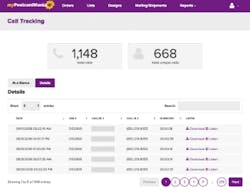The ultimate dental marketing plan: 23 steps to 147% more patients
If you're looking for a dental marketing plan article that is comprehensive, all-inclusive, and based on facts and real results from dental practices all around the country, you're in the right place. There are thousands of articles online about dental marketing plans, so I brainstormed how I could make my article different. The answer: talk to actual dentists rather than marketers to find out what they did.
I interviewed many of my dental clients, both dentists and their marketing managers, who have succeeded at consistently growing their monthly new-patient counts and revenues. Considering their results, they did this pretty quickly. Then I learned that many of them followed a sequence of steps, meaning a bona fide dental marketing plan.
So, I mapped and tallied the entire process and laid it out in this article so that you can use it to replicate their success. So, strap in, I’m going to cover a lot! But it’s worth it to take the time to read this, I guarantee.
1. Track your response to stop wasting money on ineffective marketing tactics
Tracking your marketing tells you which strategies worked so that you know where to reinvest your marketing dollars and where not to.
2. Give your receptionist an easy new caller sheet
A new caller sheet gives your receptionist a foolproof way to collect all the must-have information you need from prospective patients, such as their names, phone numbers, email addresses, and how they heard about your practice. This is such an easy tracking system to implement, and all you need to do is print off a stack of these sheets and train your receptionist to use them.
3. Assign a unique call tracking number to each marketing channel
Call tracking is a very affordable service that rings into your practice like normal, logs how many times that phone number is used, by whom and how long each call lasts, and records the calls so you can replay them any time for training purposes.
Here’s an example of a call tracking dashboard (from a client of mine), where call tracking information and recordings are accessible 24/7 in real time. Call tracking numbers are extremely affordable, so there’s really no reason to not use them.
4. Keep as simple spreadsheet to track your results, or choose a CRM with this function
Once you have the first three instructions up and running, you need to organize that data so that it's useful. Keeping a spreadsheet of your tracking results will tell you how many leads and new callers you received that week, from which marketing sources, how many booked appointments, and your revenue per week. Update your spreadsheet every week, without fail. You can download a ready-to-go, results-tracking spreadsheet here.
5. Train staff to handle new callers and increase new appointments 161%
Do you know what happens when potential new patients call in, and I mean know for a fact? If your receptionist is botching prospect calls, you may not know it. Take Dr. Jason Monroe, a client and the owner Village Green Dental in Aurora, Illinois. When he started using our call tracking service, he learned some training was in order. The result? His new patient conversion increased by 161%.
6. Investigate what makes your competition attractive to prospective patients
Do you know who your direct competitors are? Perform a quick Google search and note which three dental offices turn up in the local map pack. Here's an example of how that looks.
The practices that show up in the Google map pack are your greatest competition, since more searches now happen on mobile than desktop. Also consider asking staff to bring in any postcards or direct mail they receive at home from nearby practices. Dentists who mail postcards mean business and can easily snatch up some of your market share if you aren't also actively mailing. Once you identify a list of competitors, here’s your next step.
7. Sign up for competitor emails and newsletters
Find out what your competitors are saying and how they market to their prospective patients. You may be surprised at what you learn. How often do they follow up with prospects via phone and email? What types of promotions and discounts do they offer? What type of content do they send? What is their referral strategy? What new technologies did they add to their practice? Seriously, you need to know your competition more intimately than just their names and locations.
8. Blind shop your competitors to gain insight on their entire patient experience
“Blind shopping” is easy. Just call your competitors and act like a prospective new patient. Ask questions and see how they handle your inquiry. You want to learn everything you can about how they handle prospective new patients so that you can do it better. I recommend blind shopping your competitors via email and phone to gain a fully-rounded assessment of how they treat new leads. (You shouldn’t feel unethical blind shopping your competition. Almost every industry does blind shopping.)
9. Develop a unique selling proposition (USP)
A USP is a precise statement that quickly tells prospects how your practice differs from the competition. Here are a few examples.
• We’re the only Jamestown dentist that makes crowns on site.
• We accept more insurances than any other dentist in Danville.
• We’re ranked the #1 children’s dentist in Denver by 5280 Magazine.
• We’re the only Brookfield dentist that offers 24/7 emergency care.
Once you nail down your USP, you need to put it on all of your marketing. Now it’s time to get to the external marketing part of your overall dental marketing plan.
10. Establish a marketing budget that will grow your practice
To start off, you need to establish what percentage of your gross annual revenue this will be. Some suggestions are 5% to 10% if you’re an established but growing practice, more than 10% if you’re a new startup practice, and 3% to 5% more than you’re currently spending if your practice is stagnant or declining.
Once you've done the math, allocate a specific portion of your budget every month to each type of marketing you want to do. Here’s the trick: commit to spending that much consistently for six months. I know that sounds scary, but trust me, consistent marketing equals successful marketing. Next, you'll want to make sure to do this:
11. Analyze your budget quarterly to see what worked
Focus on how many leads each type of marketing brought in, how much revenue each type of marketing brought in, how much you spent on each marketing avenue, and what the ROI was on each type of marketing. Once you've gathered that data, consider allocating more budget into categories with higher ROIs. Remember, as your new-patient numbers and revenue steadily rise, consider increasing your budget. As your revenue grows, so should your marketing budget.
12. Target new patients based on data, not intuition
Even though everyone needs a dentist, not everyone is your ideal patient. Enter, targeting. You want to identify your ideal patients. The best way to do this is to go through your current patient database and examine commonalities. How far do they live from your practice? Are they single or married? Are they professionals who work 9 to 5? Do they have children, and if so, how old are they? What type of insurance do they have? You might be surprised by this information.
13. Get a mailing list targeting the profile you built in #12
The quality of your mailing list can make or break your dental marketing plan. It doesn't matter how perfect your design and offer are. If you mail to a bad list, you're throwing away your money. A good mailing list is filled with qualified prospects with at least 90% guaranteed deliverability. Pro tip: When you mail to the right people, any digital ads you run concurrent to your mailing, such as Google and Facebook ads, should reach the same people.
14. Mail postcards to generate a 1,809% ROI
Direct mail remains one of the most effective ways to generate new patients and grow revenue, even today. Here’s the formula for a successful postcard campaign:
• Identify your ideal new patients.
• Buy a mailing list from a list broker that guarantees 90% deliverability.
• Design a postcard. (Twelve design tips up next.)
• Create a special offer that attracts new patients. My clients have had success with $79/$89/$99 new-patient exams or cleanings.
• Mail your postcards consistently to your mailing list every month for a minimum of three months. I recommend six months to one year.
Using consistent postcard campaigns, my dental clients have generated ROIs of 998%,1,809%, and even has high as 2,079%. Take this dentist for example:
Dr. Khanna added Google ads to his postcards in 2012 using DirectMail2.0, and you can see how his revenue responded—$2 million in revenue and up. His new patients? He averages 158 per month. In fact, he’s had to triple his staff and build a new practice just to keep up with these numbers. Want to know the secret to designing a new-patient-generating postcard? Here’s #15.
15. Use these 12 design elements to increase new patients 156%
A well-designed postcard campaign stacks the odds in your favor of bringing in new patients. For example, Dr. Seth Hall mailed this postcard every month for a minimum of six months and increased his average monthly new patients by 156%. Here is his design.
This design works so well because it has a bold, straightforward headline, a five-star graphic and testimonial, a real photo of the dentist, and multiple special offers. Even if you cringe at the thought of discounting your services, 62% of our cataloged successful dental campaigns feature two or more offers. If you want to go more in-depth with the design, you can download and print off these 12 design elements for free for easy reference.
16. Add Google ads to your direct mail campaign and increase response by 400%
Running Google ads alongside a postcard campaign exponentially increases the rate at which prospective patients see and respond to your dental marketing. By how much? By 400%.1 The key is the Google Ad network, the largest online ad network in the world. That added exposure adds exponentially to your practice's legitimacy.
17. Place your ads where 68% of adults spend 50 minutes per day
Yes, I’m talking about Facebook, which has become a must-have in your dental marketing plan. I recommend you use Facebook ads in your coordinated direct mail and Google ads strategy. This three-pronged approach puts your marketing everywhere prospects spend their time today—at home, on the internet as they browse and shop they're favorite sites, Facebook, and Instagram. For an affordable all-in-one marketing solution that includes campaign tracking software, you can use Everywhere Small Business and save time marketing and growing your practice.
18. Use this to capture 95% of the leads who visit your website
You read right: 95% of prospective patients will visit your website before they decide to you call or not.4 To combat this trend, address your website. Here are three ways to take your website and get more leads from it:
• Add a lead-capture form to each page so it’s easy for prospects to contact you.
• Install a pop-up or two, or have a website developer do this, or use the affordable catch-that-lead tool.
• Use dedicated landing pages for your campaigns.
19. Use a landing page that matches the design of your campaign
A landing page is simply a web page that is designed specifically to maximize lead capture. You send traffic to the page from other marketing sources, such as postcards or Facebook. The benefits of a clear landing page include prospects instantly knowing they're in the right place, increased traffic conversion rates, and a reduced bounce rate. Landing pages are not expensive to set up, but they could mean the difference between generating lots of leads from your campaign.
20. Check your website for these six lead-generating elements
Too often, practice owners consider their website to be an online storefront. But your website is a tool. It is a means to get that lead from an interested visitor or browser into a real, tangible lead that you can follow up with until that lead becomes a patient in your chair. You can sharpen that tool with these elements:
1. Lead capture forms, to capture leads not yet ready to book that appointment
2. Real photos, not stock photos, of you, your practice, and your staff
3. An “About us” page with real and personable information
4. Reviews with five-star graphics, not just testimonials
5. Video content that makes it easy for visitors to see, listen to, and get to know you
6. Mobile-friendly design so that your website looks professional on every device
21. Install Google Analytics on your website ASAP
Google Analytics reigns as number one in website tracking, and you can use it in many ways to inform your dental marketing plan. You can create a free account and set it up on your website or have someone do it for you. After it's installed, you'll know who’s visiting your website, where they’re coming from (Facebook, Google, Pinterest, etc.), which pages they navigate to most from the homepage, which pages people abandon, and more data that can be used to tweak your marketing plan. Even if you’re not sure how to use Google Analytics yet, get it installed and dive in. You'll learn as you go.
22. Generate referrals trusted by 85% with five-star Google reviews
Reviews have become a necessary element of your dental marketing plan. Consumers today pay attention to reviews, and more specifically, Google reviews. Google is where 90% of mobile searches happen.6 We are now primed as consumers to look for those star graphics, which are prolific on the likes of Google and Amazon. How can you get that desirable five-star graphic?
• Ask your patients for up to 70% more reviews7
• Add reminders to your email signature
• Encourage staff to ask happy patients as they leave
• Use a service such as Podium to automate the process and make mobile reviews easier
• Respond to all negative reviews from your Google My Business account
The last one can't be ignored, though it will be painful, because 30% of consumers pay attention to how you handle negative reviews when deciding if they’re going to do business with you or not.5
23. Plan for the long haul and market all year long
Here's the deal: the first time someone sees your ad, whether on a postcard, Google, or Facebook, they may not need a dentist at that moment. However, when they see your practice over and over and become more familiar with you, who do you think they will remember later when they do need a dentist? You!
One of my clients, Borealis Dental Studio, learned this lesson from the get-go. They started mailing 6,000 postcards per month, and after just six months, their new patients jumped from 28 per month to 46, a 64% increase.
Then, due to their success, they doubled their mailings to 12,000 pieces per month and added Google ads to the mix. Their results after just one year of this dental marketing plan were $228,000 in revenue directly from the postcards, a return on investment of 998%, and a 143% increase in monthly new patients.
Here's a graph of their progress:
No matter what you start with, this is how you succeed—be consistent and commit to marketing, track your results, reinvest into the strategies that have proven their success, and repeat, repeat, repeat. That's the real core of any successful dental marketing plan and now it's at your fingertips.
Good luck and I hope you reap success with this information!
Want to see dental postcards that have worked? Check out the dental postcard design gallery here and request free postcard samples.
REFERENCES
1. Irvine M. Shopping Remarketing Lists Can Increase Your CTR & CVR by 400%. Wordstream website. https://www.wordstream.com/blog/ws/2015/10/21/shopping-remarketing-lists. Published April 9, 2018, accessed June 8, 2018.
2. Greenwood S, Perrin A, and Duggan M. Social Media Update 2016. Pew Research Center website. http://www.pewinternet.org/2016/11/11/social-media-update-2016/. Published November 11, 2016, accessed June 8, 2018.
3. Constine J. Users Average 50 Minutes Per Day on Facebook, Messenger, and Instagram. Tech Crunch website. https://techcrunch.com/2016/04/27/facediction/. Published April 27, 2016, accessed June 8, 2018.
4. Forer L. Direct Mail: How to Succeed in a Digital Era [Infographic]. MarketingProfs website. https://www.marketingprofs.com/chirp/2017/32948/direct-mail-how-to-succeed-in-a-digital-era-infographic. Published November 21, 2017, accessed May 7, 2018.
5. Local Consumer Review Survey 2017. BrightLocal website. https://www.brightlocal.com/learn/local-consumer-review-survey. Published 2017, accessed May 7, 2018.
6. Mangles C. Search Engine Statistics 2018. SmartInsights website. https://www.smartinsights.com/search-engine-marketing/search-engine-statistics. Published January 30, 2018, accessed May 7, 2018.
7. Bonelli S. 70% of Consumers Will Leave a Review For a Business When Asked. SearchEngineLand website. https://searchengineland.com/70-consumers-will-leave-review-business-asked-262802. Published November 14, 2016, accessed May 7, 2018.
For the most current practice management headlines, click here.
For the most current dental headlines, click here.
About the Author

Joy Gendusa
Founder and CEO
Joy Gendusa is the founder and CEO of PostcardMania. Using just postcards, a phone, and a computer, Joy built PostcardMania from a one-person startup into an industry leader serving more than 80,000 clients, plus more than 6,000 dentists. Need help promoting your practice? Call one of PostcardMania's dental marketing consultants at (866) 812-8443, e-mail Joy at [email protected], or visit postcardmania.com/dentaldesigns.
Updated April 27, 2016






